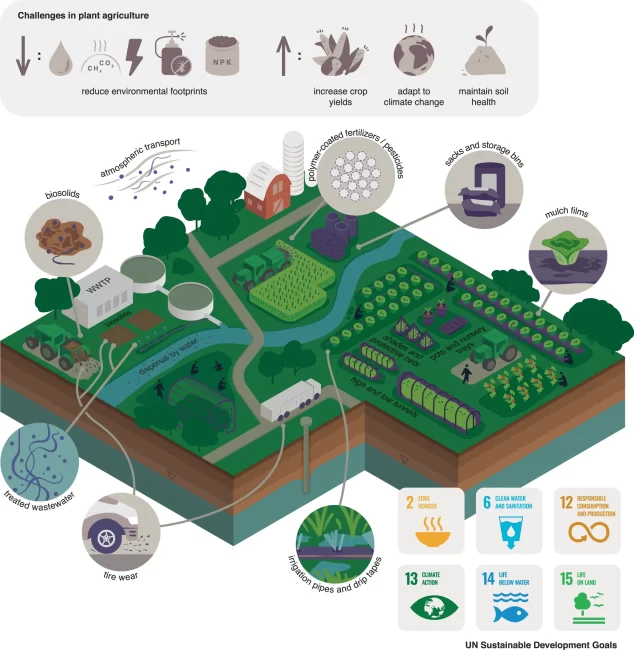EOHSI Division of Environmental and Population Health Biosciences on September 25, 2023
Plastics can be used more sustainably in agriculture
Source: Nature.com: Communications Earth and Environment – September 25, 2023
It is impossible to imagine our world and “daily life” without plastics and modern agriculture is no different with 12 million metric tons used every year. However, the consequences on human health and the environment are poorly understood. Emerging data are very alarming with micronanoplastics -the tiny fragments of plastics as a result of their environmental degradation- found in the air we breathe the water we drink and the food we eat and more alarmingly in our bodies (i.e blood, placenta, lungs, etc). An international team of authors which includes Philip Demokritou, Henry Rutgers Chair and Professor at School of Public Health addresses the environmental health implications in a recent study in Nature Communication Earth and Environment. The research shows the benefits and risks of using plastics in agriculture, and identifies sustainable solutions that can be used to protect the environment and safeguard public health.
Key points from the study:
Plastic use in agriculture enhances food production yields while shrinking our ecological footprint: Modern agriculture, which is responsible for almost a third of global greenhouse gas emissions encompasses a heavy use of plastics.
The study reveals the multi-faceted role of plastics in the food production chain: from mulch films that protect plants to water-saving irrigation, etc. For example, mulch films, which account for about 50% of all plastics used in agriculture, not only control weeds and pests, but also preserve soil moisture, regulate temperature, and improve nutrient uptake and plant growth. In China alone, if much films are to be abandoned would require an additional 4 million hectares of cropland to maintain the status quo of production.
The dark side of plastics in our food systems: The intensive use of plastics in agriculture over the last 40 years brings to our society a number of environmental health challenges. Examples include impaired soil fertility which can affect plant growth and production yields, and more recently findings that confirm the leaching of toxic additives and tiny fragments of plastics called micro-nanoplastics into environmental media (i.e. water, air ). In addition, petroleum-based plastics are not biodegradable and persist in the environment, with residues accumulating in the soil and can also be taken up by plants as they break into tiny plastic particles and enter our food chain through the prey-predator path.
We need a more sustainable approach in terms of plastic use in agriculture taking into consideration potential life cycle implications: The study presents a more sustainable path towards the use of plastics in modern agriculture. Such strategy champions the so called “3R waste hierarchy”: Reduce the use where possible, Reuse and use cutting-edge Recycling methods. In cases where plastics remain in the environment, the use of biodegratable and non toxic bioplastics rather the non petroleum-based plastics will ensure complete biodegradation. Furthermore, it is crucial that toxic plastic additives are replaced by safer alternatives. The proposed sustainable strategy is in line with the UN Plastics Treaty (UNEA 5.2). Adopting such practices will foster more sustainable use of plastics in agriculture while minimizing the impact on the environment and public health
Publication in Nature Communication Earth & Environment:
“Plastics can be used more sustainably in agriculture”. Communications Earth & Environment, Springer Nature (2023)
DOI : 10.1038/s43247-023-00982-4
Additional publications on the life cycle health implications of plastics and sustainable materials in the agriculture and food domain from the Rutgers Nanoscience and Advanced Materials Center (Director, Prof. P. Demokritou):
- Yang, Z et al. Micro- and nanoplastics (MNPs) and their potential toxicological outcomes: State of science, knowledge gaps and research needs.Nanoimpact,Vol. 32, 2023 https://doi.org/10.1016/j.impact.2023.100481.
- DeLoid GM, et al.. Incineration-Generated Polyethylene Micro-Nanoplastics Increase Triglyceride Lipolysis and Absorption in an In Vitro Small Intestinal Epithelium Model. Environmental Science & Technology. 2022 August. 56 (17), 12288-12297. DOI: 10.1021/acs.est.2c03195. [link]
- DeLoid GM, et al. Toxicity, uptake, and nuclear translocation of ingested micro-nanoplastics in an in vitro model of the small intestinal epithelium. Food and Chemical Toxicology. 2021 Dec. 158, 112609. [link]
- Cary CM, et al.. Ingested Polystyrene Nanospheres Translocate to Placenta and Fetal Tissues in Pregnant Rats: Potential Health Implications. Nanomaterials. 2023 February. 13(4):720. https://doi.org/10.3390/nano13040720. [link]
- Cary CM, et al. Single inhalation exposure to polyamide micro and nanoplastic particles impairs vascular dilation without generating pulmonary inflammation in virgin female Sprague Dawley rats. Part Fibre Toxicol. 2023 April. 20, 16. [link]
- Tao Xu, et al. Enhancing agrichemical delivery and plant development with biopolymer-based stimuli responsive core-shell nanostructures. ACS Nano. 2022 April. 16 (4), 6034-6048. [link]
- Cohen Y, et al. Quaternized chitosan as a biopolymer sanitizer for leafy vegetables: synthesis, characteristics, and traditional vs. dry nano-aerosol applications. Food Chemistry. 2022 June. 378, 132056. [link]
- Zhao Z, et al. Sustainable Nutrient Substrates for Enhanced Seedling Development in Hydroponics. ACS Sustainable Chemistry & Engineering. 2022 June. 10 (26), 8506-8516. DOI: 10.1021/acssuschemeng.2c01668. [link]
- Chang H, et al.High-throughput coating with biodegradable antimicrobial pullulan fibres extends shelf life and reduces weight loss in an avocado model. Nature Food. 2022 June. 3, 428–436 (2022). https://doi.org/10.1038/s43016-022-00523-w [link]
- Aytac Z, et al.. Enzyme- and Relative Humidity-Responsive Antimicrobial Fibers for Active Food Packaging. ACS Applied Materials & Interfaces. 2021 Oct. 13 (42), 50298-50308. [link]
- Xu T, et al. Enhancing agrichemical delivery and seedling development with biodegradable, tunable, biopolymer-based nanofiber seed coatings. ACS Sustainable Chem. Eng. 2020 June 5. 8(25):9537-48. [link]
- Aytac Z, et al. Development of biodegradable and antimicrobial electrospun zein fibers for food packaging. ACS Sustainable Chem. Eng. 2020 Sept 21. 8(40):15354-65. [link]
- Huang R, et al. A novel antimicrobial technology to enhance food safety and quality of leafy vegetables using engineered water nanostructures. Environmental Science: Nano. 2020 Dec 17. 8:514-26. [link]
Copyright © 2021, Rutgers, The State University of New Jersey


